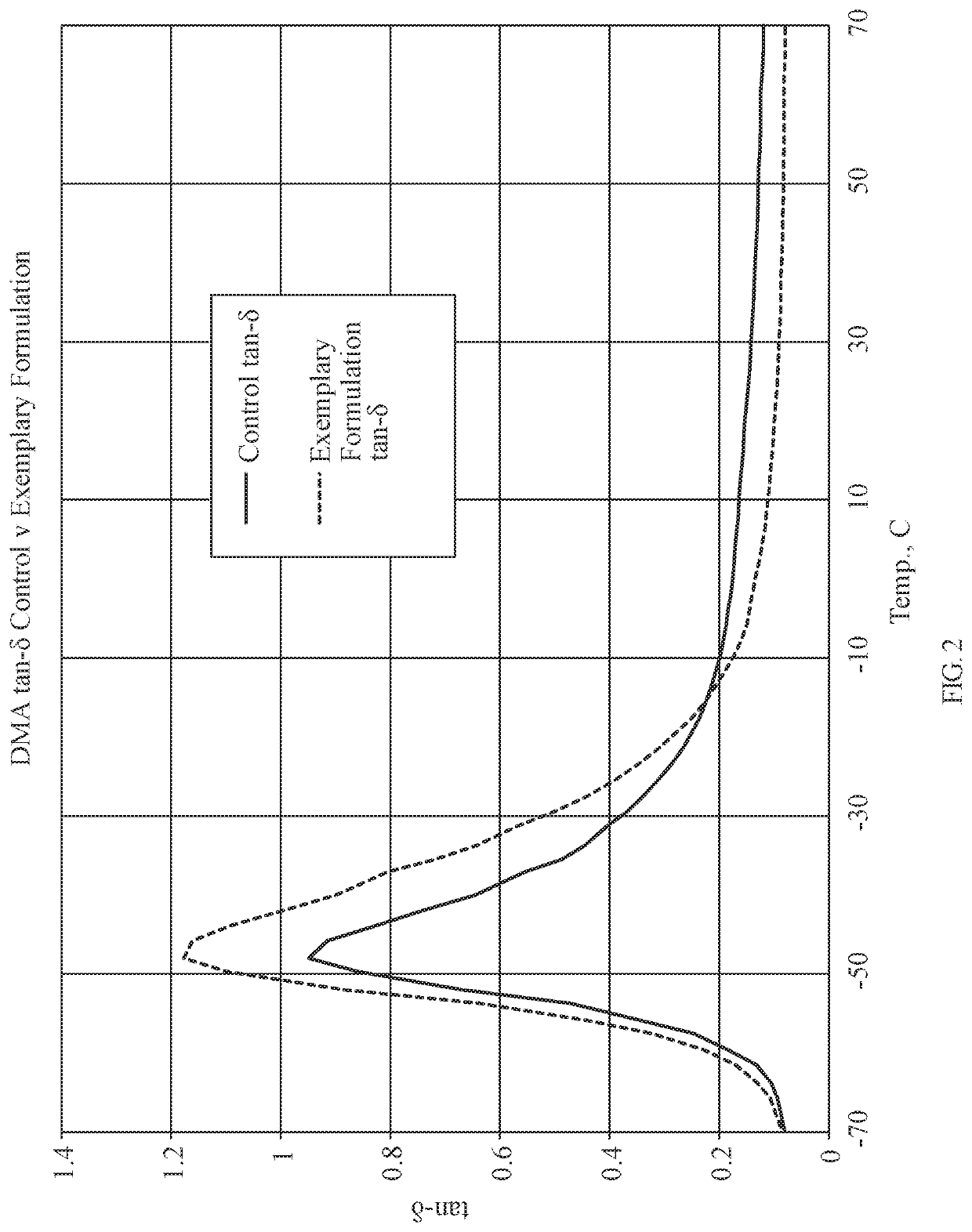Molecular composites of functional silica and natural rubber
a technology of functional silica and natural rubber, applied in the field of rubber composites and methods of making the same, can solve the problems of significant energy loss of tire rolling resistance, emissions of significant quantities of dilute ethanol vapor during rubber compounding, and the inability to realize true green tires, etc., to achieve the effect of reducing fuel consumption, low rolling resistance and increasing the driving range of electric vehicles
- Summary
- Abstract
- Description
- Claims
- Application Information
AI Technical Summary
Benefits of technology
Problems solved by technology
Method used
Image
Examples
example 1
[0322]According to one embodiment, a stable natural rubber latex / SSQ oligomer may be realized and the resulting composition could have useful properties. In various embodiments, the disclosed composition may be formulated via the following steps: 1) add distilled water to a natural rubber latex, 2) add glucono delta-lactone (GDL), 3) stir for a period of time 4) add aminoalkylsilsesquioxane oligomer in aqueous solution, 5) stir for a period of time, 6) wait for a period of time for the resulting mixture to acidify to a desired pH level, 7) dewater the mixture and press at a specific temperature.
[0323]For example, in one embodiment, the formulation may include:[0324]1. Provide approximately 40 grams ammonia-stabilized, centrifuge-concentrated 62% natural rubber latex, pH 10.5.[0325]2. Add approximately 100 grams distilled water.[0326]3. Add approximately 4 grams glucono delta-lactone (GDL).[0327]4. Stir the above solution for approximately 30 seconds (using a low-shear magnetic stir ...
example 2
[0333]In several embodiments, a scaled-up process for the formation of the disclosed composition is described, and the steps of the process is generally the same as the above example. For example, in one embodiment, the formulation may include:[0334]1. Provide approximately 330.4 grams 62% natural rubber latex.[0335]2. Add approximately 800 grams distilled water[0336]3. Add approximately 32 grams GDL[0337]4. Stir the above solution for approximately 30 second using a magnetic bar stir[0338]5. Add approximately 85 grams aminopropyl / methyl-silsesquioxane oligomer[0339]6. Stir the above solution for approximately 60 seconds using a magnetic bar stir[0340]7. End solution of approximately 1285.4 grams[0341]8. Wait approximately 6 hours for acidification to an approximate pH 5.0[0342]9. Remove gel from the serum, press dewater, and dry for approximately 72 hours at approximately 122° F.
[0343]In the above example, the natural rubber latex may coagulate to serum and gel after 6 hours of aci...
example 3
[0344]In the present example, a process for forming the disclosed composition is described, but the addition of the distilled water is eliminated, which suppresses the gel-serum separation and retains substantially all of the oligomer in the NR, as confirmed by TGA. In this example, the latex-oligomer blends are poured into pans and dried with no gel-serum separation. In the below table, AP-V refers to aminopropylsilsesquioxane-vinylsilsesquioxane (for example, Gelest WSA-6501), and AP-M refers to aminopropylsilsesquioxane-methylsilsesquioxane (for example, Gelest WSA-7011). For example, the results of six samples are shown in the below tables.
[0345]In the present example, the process for the samples are as follows: 1) add glucono delta-lactone to approximately a 20% silsesquioxane oligomer solution, 2) mix for a period of time, 3) add defoamer (for example, BYK-1740) to 62% natural rubber latex, 4) low shear mix the natural rubber latex and defoamer for a period of time, 5) low she...
PUM
| Property | Measurement | Unit |
|---|---|---|
| pH | aaaaa | aaaaa |
| time | aaaaa | aaaaa |
| time | aaaaa | aaaaa |
Abstract
Description
Claims
Application Information
 Login to View More
Login to View More - R&D
- Intellectual Property
- Life Sciences
- Materials
- Tech Scout
- Unparalleled Data Quality
- Higher Quality Content
- 60% Fewer Hallucinations
Browse by: Latest US Patents, China's latest patents, Technical Efficacy Thesaurus, Application Domain, Technology Topic, Popular Technical Reports.
© 2025 PatSnap. All rights reserved.Legal|Privacy policy|Modern Slavery Act Transparency Statement|Sitemap|About US| Contact US: help@patsnap.com



